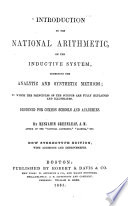 | Benjamin Greenleaf - 1854 - 342 páginas
...remainder by the ratio less 1, and the quotient will be the sum of the series. Or, RULE II. — Baise the ratio to a power whose index is equal to the number of terms, from which subtract I ; divide the remainder by the ratio less 1, and the quotient, multiplied by the... | |
 | Benjamin Greenleaf - 1857 - 336 páginas
...this remainder by the ratio, less 1, and the quotient will be the sum of the series. Or, RULE. 2. — Raise the ratio to a power whose index is equal to the number of terms, from which subtract 1 ; divide the remainder by the ratio, less 1, and the quotient, multiplied by... | |
 | Charles Guilford Burnham - 1857 - 342 páginas
...term, the number of terms, and the ratio are given, to find the sum of the series — RULE. Involve the ratio to a power whose index is equal to the number of terms,- from which subtract 1 ; divide the remainder by the ratio less 1, and the quotient, multiplied by the... | |
 | Benjamin Greenleaf - 1860 - 324 páginas
...to the sixth power, and then multiplying that power by the first term. Hence the following RULE. — Raise the ratio to a power whose index is equal to...of terms less one ; then multiply this power by the Jirst term, and the product is the last term, or other extreme. NOTE. — This rule may be applied... | |
 | Daniel Adams - 1861 - 452 páginas
...Hence, The first term, ratio, and number of terms being given, to find the sum of the series, RULE. Raise the ratio to a power whose index is equal to the number of terms, from which subtract 1, and divide the remainder by the ratio less 1 ; the quotient i» the sum of a... | |
 | Benjamin Greenleaf - 1861 - 338 páginas
...this remainder by the ratio, less 1, and the quotient will be the sum of the series. Or, RULE. 2.— Raise the ratio to a power whose index is equal to the number uf terms, from which subtract 1 ; divide the remainder by the ratio, less 1, and the ifnotient. multiplied... | |
 | William Frothingham Bradbury - 1868 - 270 páginas
...Substituting this value of I r in the formula in Case II. we have rn 1 . RULE. From the ratio raised to a power whose index is equal to the number of terms subtract one, divide the remainder by the ratio less one, and multiply the quotient by the first term.... | |
 | Benjamin Greenleaf - 1870 - 336 páginas
...every less term is the result of a division of the term next larger, by ratio. Hence the RULE. — Raise the ratio to a power whose index is equal to...less one ; then multiply this power by the first term to find the last, or divide it by the last term to find the first. NOTE. — This rule may be applied... | |
 | Benjamin Greenleaf - 1871 - 350 páginas
...every less term is the result of a division of the term next larger; by ratio. Hence the RULE. — Raise the ratio to a power whose index is equal to...less one; then multiply this power by the first term to find the last, or divide it by the last term to find the first. NOTE. — This rule may be applied... | |
 | Benjamin Greenleaf - 1874 - 348 páginas
...every less term is the result of a division of the term next larger, by ratio. Hence the RULE. — Raise the ratio to a power whose index is equal to...less one ; then multiply this power by the first term to find the last, or divide it by the last term to find the first. NOTE. — This rule may be applied... | |
| |